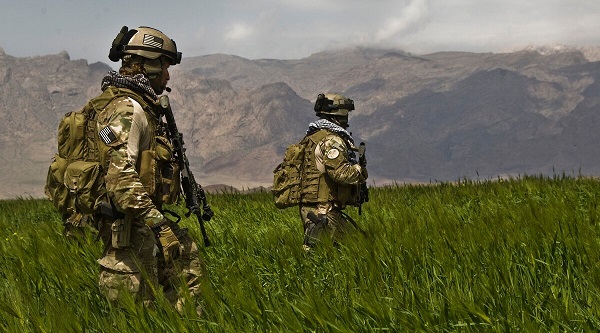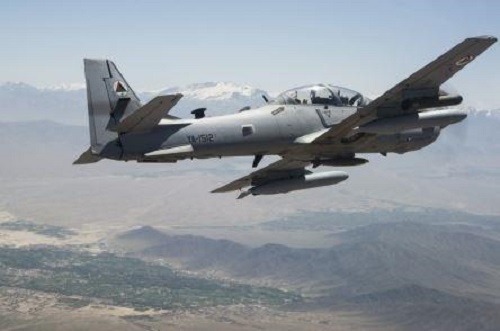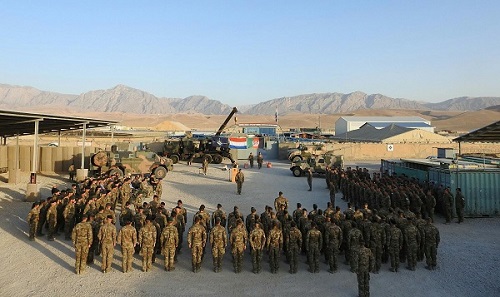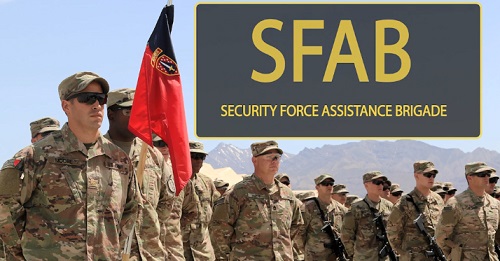
A sampling of curated news, commentary, and analysis about America’s longest war – or the Afghanistan quagmire . Topics include security, governance, Resolute Support, ANDSF, elections, peace negotiations, and more.
“If we wanted to fight a war in Afghanistan and win it, I could win that war in a week. I just don’t want to kill 10 million people. I have plans on Afghanistan, that if I wanted to win that war, Afghanistan would be wiped off the face of the earth. It would be gone. It would be over in – – literally, in 10 days, and I don’t want to do – – I don’t want to go that route.”
President Donald Trump, remarks made on Monday, July 22, 2019 during a meeting in the Oval Office in Washington, D.C. with Pakistani Prime Minister Imran Khan.
The Afghanistan conflict continues to involve the United States in a war that has no end. The U.S. military is attempting to get the Afghan National Defense and Security Forces (ANDSF) to be able to defeat the Taliban on the battlefield without U.S. military assistance. This level of capability and capacity would allow the U.S. to conduct an orderly departure from the Afghanistan quagmire. However, the prospect of a withdrawal of U.S. troops under those conditions are unlikely.
“I would like to just get out. the problem is, it just seems to be a lab for terrorists. It seems – I call it the Harvard of terrorists.”
President Trump on Afghanistan withdrawal during Fox News interview on July 1, 2019.
The Taliban continue to hold much of the rural countryside of Afghanistan. They have the ability to seize and control – sometimes for a few days and sometimes for a year or more – some of the more than 400 district centers in Afghanistan. In addition, they are frequently conducting terrorist bombings and assassinations in Kabul and some of the provincial capitals.
ANDSF
The ANDSF is under strength, has a significant number of troops that are ‘ghost soldiers’ or that simply do not show for work. Many of the troops are new recruits who – once trained and done with their initial tour – depart the military. There is a constant churn of ‘new’ soldiers into and out of the ANDSF. Many of the Afghan National Army (ANA) units are defensive in nature – occupying garrisons and small checkpoints. The Afghan Special Security Forces (ASSF) are carrying the fight to the enemy in a number of offensive operations – but these units are limited in number.

A-29 Training Program Successful. The recently issued SIGAR report on Afghanistan has lauded the U.S. Air Force’s program for training up Afghan pilots for the A-29 Super Tucano. Read “Watchdog Praises Afghan A-29 Training as Moody Program Winds Down”, Air Force Magazine, July 30, 2019.
“The A-29 program has proven that an incremental training approach that includes US Air Force and maintenance advisors for years to come is important to ensuring the Afghan increase their capability to perform their missions adequately.”
Page 112-113 of SIGAR report, “Divided Responsibility”, June 2019.
Hind Mi-35 Helicopter Update. Despite a lack of U.S. support for the iconic attack helicopter the Afghan Air Force (AAF) continues to attempt to fly the Russian-made gunship. Two articles are available on this topic: “The Afghan Air Force Just Can’t Quit the Hind Gunship Helicopter”, The Warzone, July 15, 2019 and “US to Afghanistan: Ditch the Mi-35”, Air Force Magazine, July 16, 2019.
US Unprepared to Equip ANDSF. The U.S. government was ‘unprepared’ to equip Afghan security forces despite spending billions on weapons and material – according to SIGAR. (Washington Examiner, July 29, 2019).

Mazer-e-Sharif, Afghanistan. July 2019.
NATO and Resolute Support
Two U.S. Troops Killed in Afghanistan. Resolute Support HQs announced that two U.S. service members were killed by small arms fire on Monday, July 29th. The AP reported that an Afghan soldier killed two Americans in an insider attack. Initial reports are that they were members of the 3rd Brigade Combat Team, 82nd Airborne Division. The incident took place in Tarin Kowt, Uruzgan province. Read “Army identifies two soldiers killed in Afghanistan”, Army Times, July 30, 2019.
Counting the two U.S. paratroopers killed on Monday there have been a total of four Resolute Support service member deaths. A Croatian soldier was killed on July 24th – and two of his fellow soldiers wounded in an IED attack. Lance Corporal Josip Briski was buried in Croatia on July 27th. SGM James Sartor of the 10th Special Forces Group was killed on July 13th.
NATO Staying the Course. The North Atlantic Treaty Organization continues to stand behind the Afghan government and provide military and funding assistance to the Afghan security institutions and the ANDSF. A ministerial meeting of NATO’s defense ministers took place in Brussels in late June where officials stated that NATO is committed to the train, advise, and assist mission.
Holly Holzer – New NATO Rep. The new NATO Deputy Senior Civilian Representative in Afghanistan has extensive knowledge and experience of the country (according to NATO’s Twitter account).
Dunford Recognizes Finland. The Chairman of the Joint Chiefs of Staff took note of Finland’s contribution – first to ISAF and now Resolute Support – over the years in Afghanistan. See “Dunford Recongizes Finnish Leader’s Contributions to Interoperability”, DoD, July 10, 2019.

1st SFAB – A Bumpy Deployment. According to one news report the Army’s 1st Security Force Assistance Brigade faced some training, logistical, and command issues while deployed in Afghanistan. In addition the SFAB faces recruitment and retention issues as well. Time spent as an ‘advisor’ is not seen as ‘career enhancing’. Read “Army SFABs need to offer more incentives to staff and retain troops, watchdog says”, Army Times, July 30, 2019. See also “The Army’s much-hyped advise-and-assist brigade couldn’t find enough soldiers to actually advise and assist, SIGAR says”, Task and Purpose, July 30, 2019.
Security
Bombings Continue. Bombings by the Taliban and other militant groups continue in Afghanistan. Some take place in the large cities while other along the major roads connecting the cities. Security personnel of the ANDSF and the Coalition (and civilians) continue to be attacked by VBIEDs, roadside bombs, and suicide bombers.
Back and Forth Battle for Districts. The Taliban continue to contest the control of districts throughout the country. The Afghan National Defense and Security Forces (mostly the ASSF or Afghan SOF) are constantly responding to these attacks. On July 2nd the Taliban took control of the strategic Kayhan Valley in Baghlan province. Some provinces, like Uruzgan, are heavily contested by the Taliban. In instances where the ANDSF do regain control of a district the question remains – can they hold on to these districts?
In the past the DOD (RS HQs) would release a district control / influence report periodically. This has discontinued – so it is a little bit harder to determine how well the battle for the districts is progressing.
ISIS Still Major Threat. Senior NATO and U.S. officials are still warning us about the threats posed by Islamic State (IS) militants in Afghanistan. The concern is that they may attempt to conduct major terrorist attacks in the West. There remain an estimated 2,000 IS Khorasan fighters in Afghanistan.
UN Report on Civilian Deaths. According to a recent United Nations report the U.S. and ANDSF are responsible for more civilian deaths than the Taliban. The report says that there were 3,812 documented civilian casualties in the first half of 2019. Read “UN Urges Parties to Heed Call from Afghans: Zero Civilian Casualties”, United Nations Assistance Mission in Afghanistan (UNAMA), July 30, 2019.
Peace Talks
7th Round of Talks. The U.S. and the Taliban have concluded their 7th series of negotiations in Doha. It is becoming apparent that the Taliban are gaining legitimacy through these talks – which began in July 2018. The Taliban are unlikely to agree to any concrete proposals as they believe they have time on their hands. The U.S. wants to leave Afghanistan and the Afghan government is dysfunctional, divided, and facing the prospect of an upcoming presidential election. There are a lot of aspects to the current peace talks where agreement must be reached. How much of the countryside will the Taliban control at the end of the day? Will the U.S. leave a force to conduct CT operations? Is the constitution to be changed? And what of the Taliban fighters? Are they to be integrated into the Afghan security forces? As the peace talks drag on the fighting continues – with violence surging across Afghanistan.
Khalilizad Update. The US Special Representative for Afghanistan Reconciliation, Zalmay Khalilizad, continues his travels around the world in search of peace. He has been in Afghanistan, Europe, Middle East, and China in the past month seeking common ground for the peace talks. His occasional optimistic proclamations of ‘progress’ are tempered by less than stellar results.
Intra-Afghan Conference. The Taliban met with members of ‘Afghan society’ in early July for two days in Doha, Qatar. It is hoped by many that this is a step forward in the Taliban and Afghan government to begin negotiations. How the Taliban have denied reports that they will hold direct talks with the Afghan government – stating there will be no direct talks until a US troop withdrawal takes place. (SouthAsianMonitor.com, July 29, 2019).
HPC – No More. President Ghani has dissolved the High Peace Council secretariat. It’s responsibilities have been transferred to the Ministry of State for Peace. The HPC was established by President Karzai in 2010 with the purpose to negotiate with the Taliban and encourage mid-level and lower-level Taliban fighters to ‘reintegrate’ into Afghans society. Most critics say the HPC was ineffective, corrupt, and a waste of money.
Governance
New Presidential Spokesman. President Ghani has appointed Sediq Sediqqi as his new spokesman. He has a long history of government media operations and good command of the English language. He can spin bad news into good news quicker than Sarah Sanders! You can follow him on Twitter at @SediqSediqqi.
Elections Update. Afghanistan’s Independent Electoral Commission (IEC) will attempt to field biometric devices for the upcoming presidential election. Previous fielding attempts were less than satisfactory. There is a lot of uncertainty about the upcoming election – some candidates have failed to launch their campaigns, some political parties are calling for an interim government, and others want the election delayed. There are a total of 18 presidential candidates – including current President Ghani.
The running mate of Ghani – a Vice Presidential hopeful – narrowly escaped yet another attempt on his life on Sunday, July 27th. The death toll on the attack of his political office is at 20. Another 50 people were wounded in the attack on the Green Trend party headquarters. Read “The nine lives of Amrullah Saleh, Afghanistan’s former spy chief and VP hopeful”, France 24, July 31, 2019.
Development
Aid to Afghanistan. A brief on aid flowing to Afghanistan by Ejaz Ahmed of the Observer Research Foundation (ORF), July 2, 2019.
“The Afghans need to pick up the spade and start doing their own digging — they must come out of the war economy mindset that facilitates aid money perpetually”.
Research Paper on Afghan Economy. This 54-page paper states that Afghanistan has to regain its status as a hub for goods, religions, and culture in the region. “Reconnecting Afghanistan: Lessons from Cross-border Engagement”, Chatham House, July 2019.
Illegal Mining. Although rich in mineral resources Afghanistan lacks the infrastructure, governance, and security needed to capitalize on these assets. A case in point is the lapis lazuli mining sector. Read “Illegal Mining Reduces Lapis Lazuli Prices in Afghanistan”, Tolo News, July 30, 2019.
Commentary
Flawed ISR Effort in Afghanistan. A USAF intelligence officer provides his perspective on the Army’s intelligence collection activities at the brigade level. Read “Stop Bombing Dirt: Resolving a Decade of Failed Aerial ISR Management”, War on the Rocks, July 30, 2019.
Troop Withdrawal Announcements. A team of writers have examined the upsurge in terrorist / insurgent morale in Syria and Afghanistan following the abrupt announcements of troop withdrawals. Read “Unintended consequences of the message surrounding US withdrawal from Afghanistan and Syria”, Small Wars Journal, July 6, 2019.
Withdraw Now. Daniel Morgan, a retired U.S. Army infantry colonel, served with the 10th Mountain and 101st Airborne Divisions. He believes that it is a strategic mistake to remain in Afghanistan. Read “It is time to reckon with blood and treasure lost in Afghanistan”, The Hill Opinion, July 28, 2019.
Ending the War. Danny Jursen, a U.S. Army major and book author, says we need to end the U.S. involvement in the Afghan conflict. Read “Ending the Afghan war (messily, yet again)”. Asia Times, July 29, 2019.
“Fatemiyun Fighters”. Over the past eight years thousands of Afghan men have fought as part of an Iranian proxy army in Syria supporting the Assad regime. Many of them are now returning home to Afghanistan. (Afghanistan Analysts Network (AAN), July 8, 2019.
Miscellaneous
Bergdahl Requests Overturn of Conviction. Military appellate judges have denied a request to dismiss the convictions of former Army sergeant Bowe Bergdahl on charges that he deserted his post in Afghanistan and endangered his fellow troops. (Stars and Stripes, July 1, 2019).
Afghanistan and U.S. Elections. Although the U.S. continues to be engaged in the Afghan conflict and the U.S. military suffers casualties every year the war seems to have slipped off the front pages of the news. However, once in a while our politicians voice the opinions and concerns on the conflict. Recently some of the Democratic presidential candidates were asked to respond to a question about Afghanistan.
The question was: “Would you commit to the full withdrawal of U.S. troops from Afghanistan by the end of your first term, or would you require certain conditions to be met before doing so?” Read their answers in “The Democratic Candidates on the War in Afghanistan”, Council on Foreign Relations, July 30, 2019.
Reports
CSIS Report. On July 10, 2019 the Center for Strategic & International Studies released a 59-page report entitledTell Me How this Ends: Military Advice, Strategic Goals, and the “Forever War” in Afghanistan. Authored by Mark F. Cancian of CSIS.
UN Report on Drugs. The United Nations Office on Drugs and Crime has released a report about opium cultivation and production in Afghanistan. Read Afghanistan Opium Survey 2018 – Challenges to Sustainable Development, Peace, and Security, UNODC, July 2019.
SIGAR Report on Drug Treatment Programs in Afghanistan. The Special Inspector General for Afghanistan Reconstruction has released an audit that assesses the State Department’s drug treatment and drug demand reduction programs in Afghanistan. The 40-page document was published in July 2019.
Videos
AAF Update. The Australian Defence Force (ADF) has produced a short (1 min) video about how the Afghan Air Force is getting better over time. Watch An Update on the Afghan Air Force: May 2019, SLDinfo.com, June 27, 2019.
**********
Top photo: Special Operations soldiers patrol a field in Farah, Afghanistan while alongside ANA Commandos. (SPC Joseph Wilson, U.S. Army).